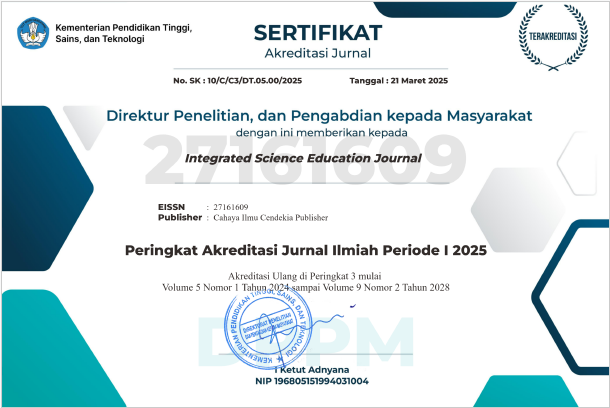Symbiotic Enlightenment: Exploring the Fascination of Biology Education Students with Religion Studies in an Academic Tapestry
Abstract
Purpose of the Study: This study aims to evaluate the interest of biology students in attending general education courses, specifically religious subjects, while exploring the impact of various factors such as gender, academic background, and extracurricular involvement. By doing so, it seeks to better understand how these factors influence students' engagement in interdisciplinary education.
Methodology: The research adopts a mixed-methods approach. It begins with quantitative analysis, employing descriptive statistics to assess general interest levels, followed by qualitative validation through interviews with seven selected informants. The study population consists of 131 active biology students in the 2023/2024 academic year, with a final sample of 100 after data cleaning. The sampling method used was total sampling to ensure broad representation.
Principal Findings: The findings reveal a variety of interest levels among biology students in religious subjects, with no significant differences based on gender, academic semester, high school major, or extracurricular involvement in religious activities or organizations. However, the school of origin emerged as a significant factor, indicating that students' previous educational experiences play a crucial role in shaping their engagement with religious subjects.
Novelty/Originality of this Study: This research introduces a novel perspective by uncovering the influence of a student’s educational background specifically, their school origin on their interest in interdisciplinary religious education. It offers new insights into how prior schooling experiences contribute to shaping students’ academic and personal interests, particularly within the context of general education courses, thus providing valuable implications for curriculum design in higher education.
References
A. N. Pane, I. D. P. Nyeneng, and I. wayan Distrik, “The effect of predict observe explain learning model against science process skills of high school students,” J. Pendidik. Mat. dan IPA, vol. 11, no. 1, pp. 111–119, 2020, doi: 10.26418/jpmipa.v11i1.32892.
F. Adinugraha, Pendekatan keterampilan proses sains [Science process skills approach], Jakarta: Gramedia, 2018.
A. Stones, J. Pearce, M. J. Reiss, and T. Mujtaba, “Students’ perceptions of religion and science, and how they relate: The effects of a classroom intervention,” Relig. Educ., vol. 115, no. 3, pp. 349–363, 2020, doi: 10.1080/00344087.2020.1769537.
S. Sukarno, K. T. Win, and D. A. C. Hong, “Teachers’ views regarding the character of students’ perseverance in science learning”, In. Sci. Ed. J, vol. 5, no. 1, pp. 59-64, 2024, doi: 10.37251/isej.v5i1.806.
Waston, Y. O. O.-O. Uthman, Mahmudulhassan, and MUTHOIFIN, “Ian G. Barbour’s thoughts on science and religion,” J. world Thinkers, vol. 1, no. 1, pp. 1–16, 2024.
B. Billingsley, R. Brock, K. S. Taber, and F. Riga, “How students view the boundaries between their science and religious education concerning the origins of life and the universe,” 2016, doi: 10.1002/sce.21213.
H. B. Nasution, K. Katimin, and P. Azhar, “Science concepts according to Syed Hussein Nasr,” Budapest Int. Res. Critics Inst. Humanit. Soc. Sci., vol. 3, no. 3, pp. 2387–2394, 2020, doi: 10.33258/birci.v3i3.1195.
A. Yaqin, “Integrasi ayat-ayat Al-Qur’an dalam pembelajaran sains (biologi) berdasarkan pemikiran Ian G. Barbour [Integration of Al-Qur'an verses in science (biology) learning based on the thoughts of Ian G. Barbour],” SPEKTRA J. Kaji. Pendidik. Sains, vol. 6, no. 1, p. 78, 2020, doi: 10.32699/spektra.v6i1.119.
H. Naja, A. N. Rizqi, R. D. Zahroh, A. A. Mahardika, and A. F. Hidayatullah, “Integrasi sains dan agama (Unity of Science) dan pengaplikasiannya terhadap penerapan materi reproduksi dan embriologi [Integration of science and religion (Unity of Science) and its application to the application of reproductive and embryology materials],” Bioedukasi J. Pendidik. Biol., vol. 13, no. 2, p. 70, 2021, doi: 10.20961/bioedukasi-uns.v13i2.37660.
R. Bistara, “Islam dan sains menurut Sayyed Hossein Nasr [Islam and science according to Sayyed Hossein Nasr],” Pros. Konf. Integr. Interkoneksi Islam dan Sains, vol. 2, p. 2, 2020.
J. Fischer, T. Jansen, J. Möller, and U. Harms, “Measuring biology trainee teachers’ professional knowledge about evolution-introducing the Student Inventory,” Evol. Educ. Outreach, vol. 14, no. 1, pp. 1–16, 2021, doi: 10.1186/s12052-021-00144-0.
V. L. Plano Clark, N. V Ivankova, and N. Yang, “Frameworks for conceptualizing mixed methods research,” International Encyclopedia of Education (Fourth Edition). Elsevier, Oxford, pp. 390–401, 2023. doi: 10.1016/B978-0-12-818630-5.11038-3.
M. D. Fetters and C. Tajima, “Mixed methods research designs,” International Encyclopedia of Education (Fourth Edition). Elsevier, Oxford, pp. 426–440, 2023. doi: 10.1016/B978-0-12-818630-5.11042-5.
I. Imron, “Analisa pengaruh kualitas produk terhadap kepuasan konsumen menggunakan metode kuantitatif pada CV. Meubele Berkah Tangerang [Analysis of the influence of product quality on consumer satisfaction using quantitative methods at CV. Meubele Berkah Tangerang],” Indones. J. Softw. Eng., vol. 5, no. 1, pp. 19–28, 2019, doi: 10.31294/ijse.v5i1.5861.
P. M. Abdullah, Living in the world that is fit for habitation : CCI’s ecumenical and religious relationships. 2015.
N. W. Sitasari, “Mengenal analisa konten dan analisa tematik dalam penelitian kualitatif [Understanding content analysis and thematic analysis in qualitative research],” Forum Ilm., vol. 19, p. 77, 2022.
Z. Luo, Y. Dang, and W. Xu, “Academic interest scale for adolescents: Development, validation, and measurement invariance with Chinese students,” Front. Psychol., vol. 10, no. October, pp. 1–14, 2019, doi: 10.3389/fpsyg.2019.02301.
A. Musnandar and A. Salim, “The integration of science and religion its implications for islamic religious education,” J. Peace Eucation Islam. Stud., vol. 1, no. 1, p. 251, 2021.
A. Hopid, “Integrasi ilmu dalam pendidikan: Membaca potensi integrasi sains dan agama di pondok pesantren mahasiswa UII Yogyakarta [Integration of science in education: Reading the potential for integration of science and religion in the Islamic boarding school of UII Yogyakarta students],” ABHATS J. Islam Ulil Albab, vol. 2, no. 2, pp. 97–114, 2021, doi: 10.20885/abhats.vol2.iss2.art2.
M. Hajj and U. Panizza, “Religion and education gender gap: Are Muslims different?,” Econ. Educ. Rev., vol. 28, no. 3, pp. 337–344, 2009, doi: 10.1016/j.econedurev.2008.01.007.
Y. Yusnidar, E. Epinur, and N. A. Nadila, “Analysis of student responses to student worksheets based on project based learning models”, In. Sci. Ed. J, vol. 4, no. 3, pp. 111-116, 2023, doi: 10.37251/isej.v4i3.718.
A. Rachmatullah, S. Diana, and M. Ha, “The effects of curriculum, gender and students’ favorite science subject on Indonesian high-school students’ conceptions of learning science,” J. Balt. Sci. Educ., vol. 16, no. 5, pp. 797–812, 2017, doi: 10.33225/jbse/17.16.797.
D. K. Cheung, D. K. Y. Tam, M. H. Tsang, D. L. W. Zhang, and D. S. W. Lit, “Depression, anxiety and stress in different subgroups of first-year university students from 4-year cohort data,” J. Affect. Disord., vol. 274, no. November 2019, pp. 305–314, 2020, doi: 10.1016/j.jad.2020.05.041.
A. Pratama, H. Helmy, and M. Afriyenti, “Pengaruh usia dan religiusitas terhadap keyakinan etis pada akuntan [The influence of age and religiosity on ethical beliefs in accountants],” J. Eksplor. Akunt., vol. 2, no. 1, pp. 2407–2427, 2020, doi: 10.24036/jea.v2i1.220.
E. A. Pantu, “Pengaruh usia terhadap regulasi diri akademik mahasiswa pada kondisi study from home [The influence of age on students' academic self-regulation in study from home conditions],” J. Psibernetika, vol. 14, no. 1, pp. 17–23, 2021, doi: 10.30813/psibernetika.
I. Purkana, “Perbandingan kemampuan kognitif dalam pemahaman pembelajaran penjasorkes antara siswa ipa dan siswa ips kelas x di sma negeri 1 Peukan Bada Aceh Besar [Comparison of cognitive abilities in understanding physical education and health learning between science students and social studies students in class X at State Senior High School 1 Peukan Bada Aceh Besar],” J. Chem. Inf. Model., vol. 53, no. 9, pp. 1689–1699, 2014.
I. R. Hayati and E. Sujadi, “Perbedaan keterampilan belajar antara siswa ipa dan ips [Differences in learning skills between science and social studies students],” Tarbawi J. Ilmu Pendidik., vol. 14, no. 1, p. 1, 2018, doi: 10.32939/tarbawi.v14i1.250.
E. F. Setiya Rini, B. Bramastia, K. Aditia, F. Fitriani, and P. Siswanto, “Analysis of science laboratory management to support science learning: A systematic review”, In. Sci. Ed. J, vol. 5, no. 1, pp. 49-58, 2024, doi: 10.37251/isej.v5i1.799.
H. Ginosyan, V. Tuzlukova, and F. Ahmed, “An investigation into the role of extracurricular activities in supporting and enhancing students’ academic performance in tertiary foundation programs in oman,” Theory Pract. Lang. Stud., vol. 10, no. 12, pp. 1528–1534, 2020, doi: 10.17507/tpls.1012.03.
A. E. King, F. A. E. McQuarrie, and S. M. Brigham, “Exploring the relationship between student success and participation in extracurricular activities,” Sch. A J. Leis. Stud. Recreat. Educ., vol. 36, no. 1–2, pp. 42–58, 2021, doi: 10.1080/1937156X.2020.1760751.
M. Amin Abdullah, “Religion, science and culture: An integrated, interconnected paradigm of science,” Al-Jami’ah, vol. 52, no. 1, pp. 175–203, 2014, doi: 10.14421/ajis.2014.521.175-203.
R. Mckay and H. Whitehouse, “Religion and morality,” Relig. Moral., vol. 141, no. 2, pp. 1–264, 2015, doi: 10.4324/9781315244778.
A. Aseery, “Enhancing learners’ motivation and engagement in religious education classes at elementary levels education classes at elementary levels,” Br. J. Relig. Educ., vol. 46, no. 1, pp. 43–58, 2024, doi: 10.1080/01416200.2023.2256487.
Copyright (c) 2024 Tesa Ulandari, Dharma Ferry, Albertos Damni

This work is licensed under a Creative Commons Attribution 4.0 International License.
Authors who publish with this journal agree to the following terms:
- Authors retain copyright and acknowledge that the Integrated Science Education Journal is the first publisher licensed under a Creative Commons Attribution 4.0 International License.
- Authors are able to enter into separate, additional contractual arrangements for the non-exclusive distribution of the journal's published version of the work (e.g., post it to an institutional repository or publish it in a book), with an acknowledgment of its initial publication in this journal.
- Authors are permitted and encouraged to post their work online (e.g., in institutional repositories or on their website) prior to and during the submission process, as it can lead to productive exchanges and earlier and greater citation of published work.







.png)
.png)






